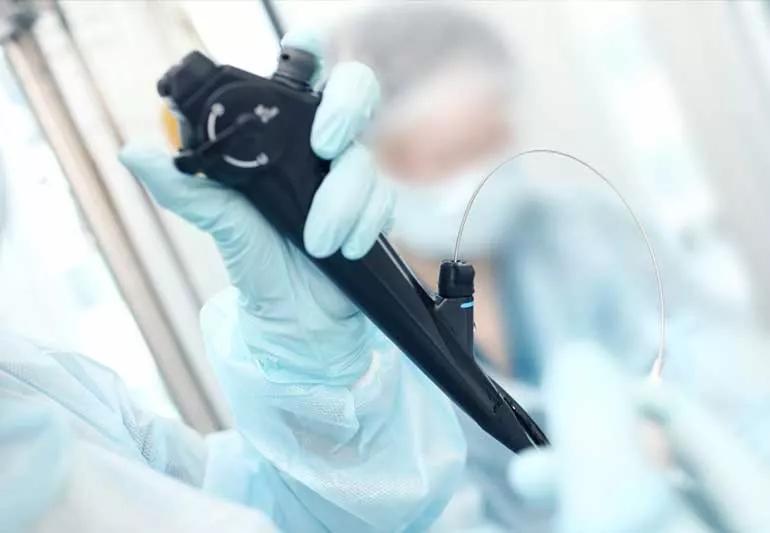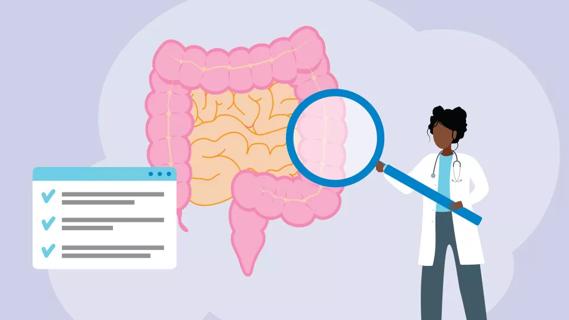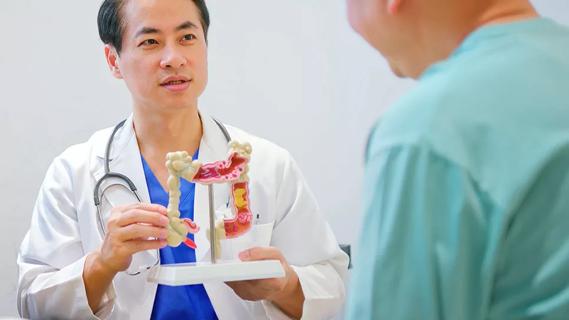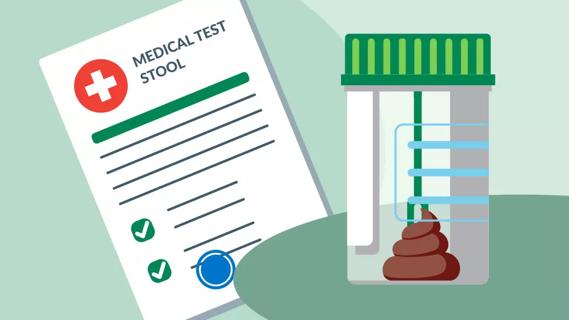Colonoscopies and sigmoidoscopies are types of endoscopies, procedures that look at the health of your large intestine

Colorectal cancer (colon cancer) is the third leading cause of cancer-related deaths in the United States each year. And while it might not always get as much press as some other cancers, that’s certainly alarming when you consider that many of us are faced with common issues involving our digestive tracts on a regular basis.
Advertisement
Cleveland Clinic is a non-profit academic medical center. Advertising on our site helps support our mission. We do not endorse non-Cleveland Clinic products or services. Policy
“The problem is in many cases, the symptoms that may be present with colon cancer are oftentimes ones we don’t routinely talk about like belly pain, rectal bleeding and constipation because they often indicate that nothing is wrong,” says colorectal surgeon Scott Steele, MD. “It’s sometimes hard to differentiate when it’s worrisome and when it’s just normal.”
That makes consistent cancer screenings and endoscopic tools invaluable when trying to identify tumors and lesions while they’re still precancerous or during their earliest stages of growth. But what tests are needed, how are they conducted, and what’s the difference between an endoscopy, colonoscopy and sigmoidoscopy? Does everyone need one? Or only those who are at highest risk for colon cancer?
Dr. Steele answers some of these burning questions.
During an endoscopy, a healthcare provider uses a long, thin tube called an endoscope. The end of this tube contains a small light and a camera that captures images and videos of the inside of your organs and other body parts. These procedures typically require some form of sedation or anesthesia so that it’s a pain-free experience. Most of these procedures allow you to go home within a couple of hours, though sometimes, you may need an overnight stay in the hospital depending on the procedure itself.
Advertisement
Depending on what your doctors are looking at, endoscopes can be inserted into any of your orifices. During an upper endoscopy, for example, the endoscope is used to view the upper half of your digestive tract. It’s inserted into your mouth to view your esophagus, your stomach and duodenum (the upper part of your small intestine).
A colonoscopy takes place on the opposite end of your body and describes a procedure when an endoscope is inserted into your anus to view the lower half of your digestive tract.
And the thing that makes a sigmoidoscopy different is that it’s an even shorter version of a colonoscopy procedure. A sigmoidoscopy looks at just the lower third of your large intestine (your colon) and sometimes, even stops at just your rectum.
“The way I would think about is that we’re one long garden hose from our mouths to our bottom,” explains Dr. Steele. “Different parts of the GI tract have different functions and different anatomy, but we can use these endoscopes at either end to look at what’s happening.”
These endoscopes often contain channels through which a healthcare provider can feed other instruments to help surgically remove tissues or tumors or perform surgeries during an exam. In this way, endoscopies serve two purposes:
A colonoscopy is an internal examination of your entire large intestine — including your anus, rectum and colon. Some of the elements doctors look for during a colonoscopy include:
“It’s not only diagnostic for many people, but it also has the ability to be therapeutic,” says Dr. Steele. “If we see a polyp, it can be removed. If we see something abnormal, we can do a biopsy and get a diagnosis by taking a piece of tissue from the lining of the colon. If there’s a narrowing of the colon, we can work through the scope and actually dilate that narrowing.”
The American Cancer Society recommends that everyone, at minimum, should begin screening for colon cancer at age 45. Then, re-test every 10 years as long as their exam results are negative, they continue to show no signs of cancer and they continue to experience no symptoms or an increased risk for colon cancer.
Advertisement
Your risk for colon cancer does increase as you age. But other things can also increase your risk for colon cancer, including:
If you’re considered high risk for colon cancer, you may want to talk to a healthcare provider about getting a colonoscopy earlier on. You may also want to consider getting a colonoscopy earlier than 45 if you experience symptoms like:
Before your colonoscopy, your healthcare provider will give you instructions on how to prepare your bowels for the procedure. If you think about it, you need to make sure the doctor has a clean path through your large intestine so they can see everything clearly.
In the hours and days leading up to the procedure, your healthcare provider will give you specific guidance that might include prescriptions for laxatives, nutrition guidelines and how much you can or can’t eat before the procedure.
Advertisement
“Some of this depends on the type of bowel prep that you decide to take,” clarifies Dr. Steele.
Some people may be able to eat normally right up until the night before. But others may need to go on a low-fiber and liquid diet a couple of days before the procedure.
“There are even situations where you might take half of the laxative the night before and half of the laxative in the morning to get out the residual type of bile and other products that your body continues to make, and that’s called a split-dose prep,” he adds. “So, different types of preps have different timing to them, and your healthcare provider will work through all of that with you prior to your procedure.”
A sigmoidoscopy is less invasive than a colonoscopy because rather than winding its way through your entire large intestine, it only covers the lower third of your large intestine. This exam focuses mostly on your descending colon (which is located on your left side), your rectum and your anus. There are two different versions of this procedure:
“These offer a limited focus of just the left side of the colon and rectum and we often use them in patients who’ve had prior cancers or prior lesions that are on their rectum or left side where we want to look at those areas in isolation,” explains Dr. Steele.
Advertisement
But unlike colonoscopies, sigmoidoscopies can only get so far into your large intestine. To get a full picture of what’s going on, a sigmoidoscopy is often not enough when it comes to screening for early signs of cancer.
“In terms of colorectal cancer screening, a sigmoidoscopy would need to be followed up with a full colonoscopy to make sure we’re able to evaluate the entire colon,” states Dr. Steele.
You may need a flexible sigmoidoscopy or proctoscopy for all the same reasons as a colonoscopy, but particularly if you:
In general, a sigmoidoscopy requires the same level of preparation as a colonoscopy. You’ll need to make sure your bowels are empty before having the procedure and your healthcare provider will advise you on any nutritional guidelines and preparation prescriptions you should follow.
In most cases, sedation and anesthesia aren’t needed during a sigmoidoscopy, but you can discuss this with your healthcare provider and any other concerns or questions you have regarding how the procedure will go.
Endoscopies are designed to be diagnostic and therapeutic, regardless of the type you have. If you’re concerned about your colon health, if you’ve never had a colonoscopy or if you experience any symptoms that are making you uncomfortable with what might be happening in your gut, talk to a healthcare provider today about if it’s time for an endoscopic exam.
“The unique thing about endoscopies is that they can detect tumors when someone is asymptomatic and they’re just at their infancy, at the small polyp stage,” says Dr. Steele.
“Other cancers, like pancreatic cancer, are oftentimes diagnosed at a later stage. But an endoscopy has the ability to detect polyps, early-stage lesions and multiple polyps throughout the colon, or to even give people a peace-of-mind that they don’t have anything growing in their colon.”
Learn more about our editorial process.
Advertisement

Focus on exercise, eating healthy and getting regular screenings to help lower your risk

Chronic inflammation from flare-ups can damage the lining of your intestinal wall, making your colon more vulnerable to cancer

A steady increase in cases in those younger than 50 started decades ago

If you’re at average risk, it’s recommended that you get your first colonoscopy at age 45

It’s a slow-moving process that offers an opportunity for early detection and treatment

At-home screening options can be good detection tools, but a colonoscopy remains the gold standard

Knowing your family history and getting a genetic test can help detect colorectal cancer earlier

Get lots of fiber, cut back on red meat and limit your alcohol intake

If you’re feeling short of breath, sleep can be tough — propping yourself up or sleeping on your side may help

If you fear the unknown or find yourself needing reassurance often, you may identify with this attachment style

If you’re looking to boost your gut health, it’s better to get fiber from whole foods